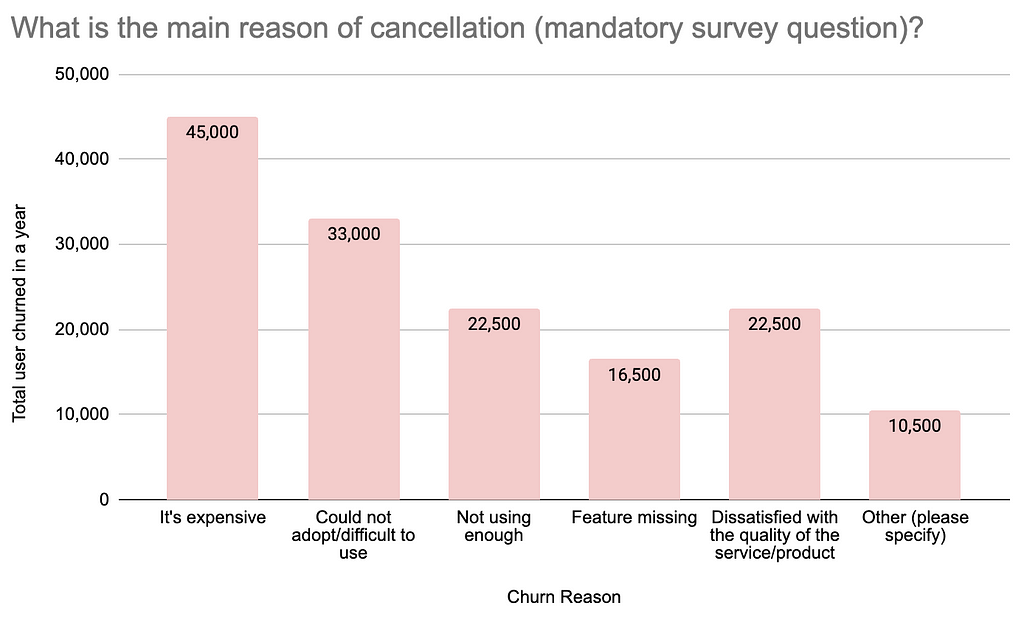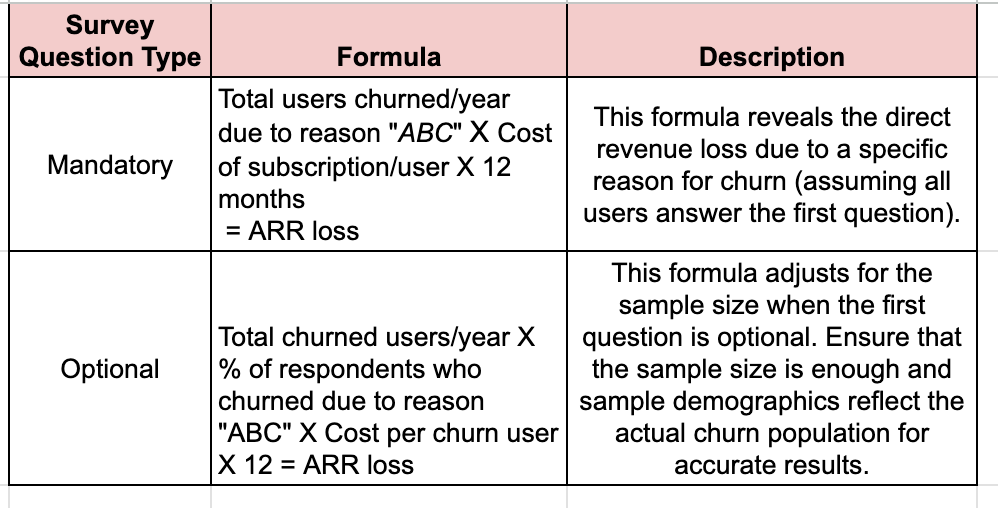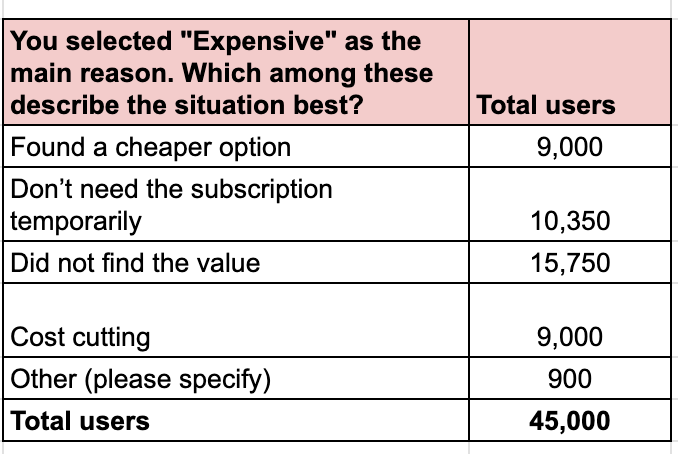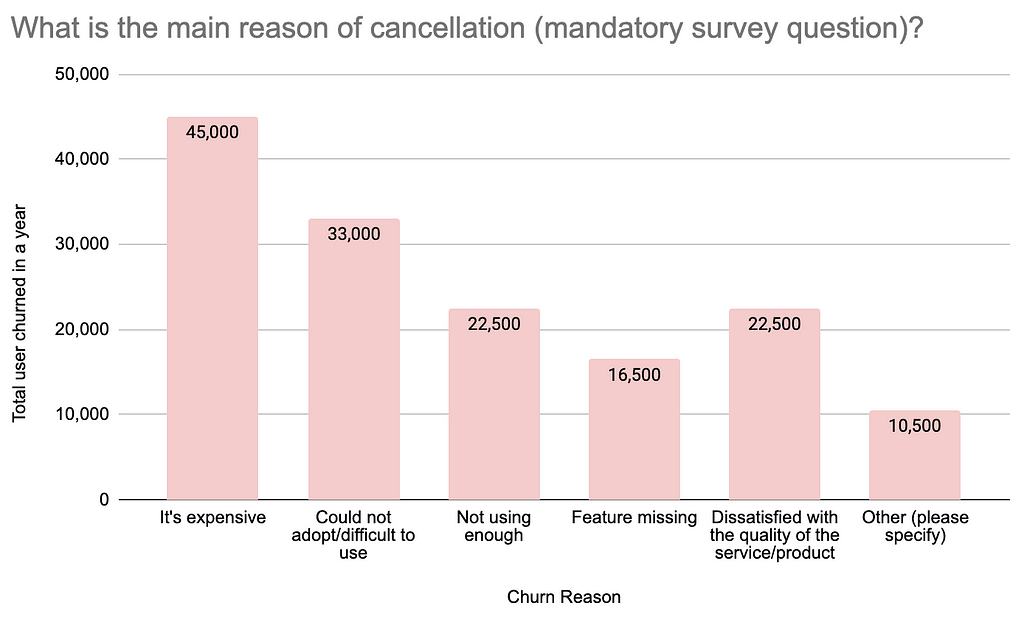
Understanding users’ needs and pain points is a critical component of business success. Churn surveys, a specific type of survey designed for customers who have stopped using a service, are a treasure trove of customer insights. However, the true power lies in transforming those insights into concrete actions that boost sustainable growth and revenue. Churn often stems from unmet customer needs, leading to lost subscriptions and revenue. This article dives into a powerful technique: “assigning a dollar value to customer problems identified through churn surveys.” You can apply this method to other types of surveys, like CSAT, NPS, and other VOC tools. By quantifying the financial impact of these problems, you can prioritize which issues to tackle first, maximizing your profitability. Prioritization is the key to every product development process.
Step 1: Analyzing the First Question — Unveiling the Root Cause
Begin your analysis with the survey’s primary question, such as “What is the main reason for cancellation?”

Quantifying the Impact
Now, let’s look into the result and quantify it in dollars. This depends on whether the first question is mandatory (all users answer) or optional (only some users answer).

So, to size one of the churn reasons, for example, “it’s too expensive”, the opportunity size would be 45,000*$20*12 = $10.8 million ARR (assuming the cost of the subscription per churn user is $20). This is revenue loss only in 1 year, in reality this would be more if customer do not churn then they pay for 3–5 years (LTV)
Tip: There are statistical methods to determine a sufficient sample size; one such is provided for free here by Qualtrics.
Tip: If the sample does not reflect the churn population, then extrapolate only for the population which is represented by the sample (segment users). And make efforts to find churn-related insights for the remaining demographic. Example: If you have an in-product churn survey and you have Small-Medium Business to Enterprise customers, then many times Enterprise customers do not churn in-product; they cancel subscriptions through renewal managers; hence, to get insights from them, incorporate a churn survey through the renewal manager path.
Step 2: Analyze the Follow-up Questions — Digging Deeper
While assigning a $ value to the high-level problem “It’s too expensive,” this provides a starting point; it’s too general to develop effective solutions. To gain deeper insights, we can use a follow-up, branched question after users select “It’s too expensive” in the initial survey.
Tip: If you only have a single survey question in the in-product cancellation flow, consider using a follow-up churn survey via email or after the cancellation flow with branched questions to gain deeper insights into customer churn reasons.
For “Subscription being too expensive,” a branched question can have the following options:

The results show that 60% of the users in the “too expensive” reason category are churning because of non-price-related issues like “did not find the value” and “don’t need the subscription temporarily.” That is why going one level deeper is important to understand the real issues. Now let’s look into calculating opportunity sizing for some of the above churn reasons:
Do not need the subscription temporarily:
Sizing opportunity: The sizing would be similar to what we did in step 1, but we need to keep in mind that certain users might be coming back automatically as they are canceling for temporary reasons. Hence, we need to remove those users from our calculation (organic win-back rate). So, if your organic win-back rate for this audience is 2%, then the final addressable ARR would be: (9000 * $20*12) — (9000* 2% * $20*12) = $2.2M ARR loss.
Potential Solutions: Now, as we know, solving the above use case can save substantial revenue; hence, we can build the solution for these users. One solution could be introducing a pause subscription option. Since the reasons for canceling are temporary (like travel, unexpected weather, pandemics, or even just a busy period can disrupt users’ routines), pausing allows users to hold onto their subscription without the burden of ongoing fees. This benefits businesses in two ways: First, it fosters customer loyalty by demonstrating flexibility and understanding user needs. Second, it increases the chance of users returning to the service once their busy period or temporary disruption has passed, leading to continued revenue.
Studies have shown that offering a pause option can significantly reduce churn rates [source]. The famous audio book subscription service Audible offers a pause subscription.
Didn’t find the value:
If users aren’t realizing the subscription’s value, it’s crucial to understand why. Do the same exercise as above to calculate the revenue you are losing because the user did not find the value in the subscription, i.e., 15700 * $20 * 12 = $3.78 million ARR. This is the revenue you can save because of the retention of these users. In addition to this, you will also be earning expansion revenue (if your business model has that option), as once users realize the value of the service, they are more likely to expand.
Potential Solutions:
- Remind users about the value: Highlight the benefits they receive. For example, Instacart shows how many shopping hours users save per order, emphasizing the value proposition.
- Launch marketing campaigns around value: Conduct user research and publish articles showcasing how your product improves users’ lives. Asana, for instance, shares stories about how work management tools enhance team productivity.
- Offer tiered subscription plans: Allow users to switch to a lower tier, encouraging them to adopt basic features before potentially upselling them to a higher tier later.
- Offer flexible billing and provide education and onboarding services and templates. Offer monthly or quarterly billing so users get time to realize the value before committing to a subscription for a longer duration, and provide onboarding tools to help users realize the value quickly.
Found a cheaper option or cost-cutting: For customers who are price-sensitive and are churning to a competitor purely because of the lower price, offering them a discount in the cancellation flow is a good option. You can save up to 20% of the ARR by building discounts in the cancellation flow. What discount to offer in the cancellation flow will depend on three factors: 1) Cost to serve the customer; 2) Offer a take-up rate 3) Retention rate after the offer expires.
By analyzing the follow-up questions for “It’s too expensive,” we can see the importance of going beyond surface-level reasons for churn. Understanding the root cause allows us to develop targeted solutions that truly address user needs and maximize the return on investment for our product development efforts.
As a product manager, I always read comments left by users in various surveys and do an exercise like the one above to think through solutions and prioritize the customer pain points. Let me know if you have questions. Let’s make solutions that are customer-centric and, at the same time, can create sustainable businesses.
How to quantify customer problems for prioritization using churn survey was originally published in Towards Data Science on Medium, where people are continuing the conversation by highlighting and responding to this story.
Originally appeared here:
How to quantify customer problems for prioritization using churn survey
Go Here to Read this Fast! How to quantify customer problems for prioritization using churn survey
